
The English Setter is a medium-size breed of dog. It is part of the setter group, which includes the red Irish Setters, Irish Red and White Setters, and black-and-tan Gordon Setters. The mainly white coat has long silky fringes on the back of the legs, under the belly and on the tail. The coat features flecks of colour, and the different colour varieties are referred to as 'belton'.

The American Kennel Club (AKC) is a registry of purebred dog pedigrees in the United States. In addition to maintaining its pedigree registry, this kennel club also promotes and sanctions events for purebred dogs, including the Westminster Kennel Club Dog Show, an annual event which predates the official forming of the AKC, the National Dog Show and the AKC National Championship. The AKC is a non-member partner with the Fédération Cynologique Internationale. The AKC recognizes 200 dog breeds, as of 2022.

The American Cocker Spaniel is a breed of sporting dog. It is a spaniel type dog that is closely related to the English Cocker Spaniel; the two breeds diverged during the 20th century due to differing breed standards in the US and the UK. In the United States, the breed is usually called a Cocker Spaniel, while elsewhere in the world, it is called an American Cocker Spaniel to distinguish it from its older English cousin. The word cocker is commonly held to stem from their use to hunt woodcock in England, while spaniel is thought to be derived from the breed's origins in Spain.
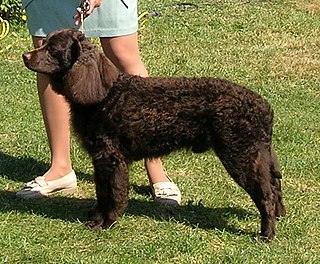
The American Water Spaniel is a breed of spaniel which originated in the United States. It was developed in the state of Wisconsin during the 19th century from a number of other breeds, including the Irish and English Water Spaniels. The breed was saved by Dr. Fred J. Pfeifer, who set up the breed club and standard, and whose work led to recognition for the breed by the United Kennel Club, and later, the American Kennel Club. While they are the state dog of Wisconsin, they remain a rare breed.

The Clumber Spaniel is a breed of dog of the spaniel type, developed in the United Kingdom. It is the largest of the spaniels, and comes in predominantly white with either lemon or orange markings. The name of the breed is taken from Clumber Park in Nottinghamshire where the breed was first developed. It is a gundog that specialises in hunting in heavy cover. They are gentle and loyal, and can act aloof with strangers. They have several habits which could be considered disadvantages, including a constant shedding of its coat and snoring.

The Cavalier King Charles Spaniel (CKCS) is a British breed of toy dog of spaniel type. Four colours are recognised: Blenheim, tricolour (black/white/tan), black and tan, and ruby; the coat is smooth and silky. The lifespan is usually between eight and twelve years.
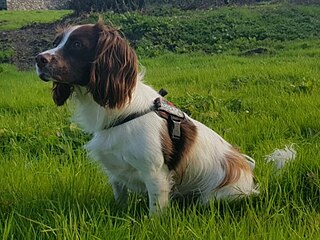
The English Springer Spaniel is a breed of gun dog in the Spaniel group traditionally used for flushing and retrieving game. They are descended from the Norfolk or Shropshire Spaniels of the mid-19th century; the breed has diverged into separate show and working lines. It is closely related to the Welsh Springer Spaniel and very closely to the English Cocker Spaniel; less than a century ago, springers and cockers would come from the same litter. The smaller "cockers" were used in woodcock hunting while their larger littermates were used to flush, or "spring", other game birds, hence the name. In 1902, The Kennel Club recognized the English Springer Spaniel as a distinct breed. They are used as sniffer dogs on a widespread basis.

Cocker Spaniels are dogs belonging to two breeds of the spaniel dog type: the American Cocker Spaniel and the English Cocker Spaniel, both of which are commonly called simply Cocker Spaniel in their countries of origin. In the early 20th century, Cocker Spaniels also included small hunting spaniels.

A spaniel is a type of gun dog. Spaniels were especially bred to flush game out of denser brush. By the late 17th century, spaniels had been specialized into water and land breeds. The extinct English Water Spaniel was used to retrieve water fowl shot down with arrows. Land spaniels were setting spaniels—those that crept forward and pointed their game, allowing hunters to ensnare them with nets, and springing spaniels — those that sprang pheasants and partridges and also rabbits and smaller mammals such as rats and mice. During the 17th century, the role of the spaniel dramatically changed as Englishmen began hunting with flintlocks for wing shooting. Charles Goodall and Julia Gasow (1984) write that spaniels were "transformed from untrained, wild beaters, to smooth, polished gun dogs."

The English Cocker Spaniel is a breed of gun dog. It is noteworthy for producing one of the most varied numbers of pups in a litter among all dog breeds. The English Cocker Spaniel is an active, good-natured, sporting dog standing well up at the withers and compactly built. There are "field" or "working" cockers and "house" cockers. It is one of several varieties of spaniel and is the foundation of its American cousin, the American Cocker Spaniel. The English Cocker is closer to the working-dog form of the Field Spaniel and the English Springer Spaniel. English Cocker Spaniels are also known as the "Merry Spaniel" due to their constantly wagging tail.
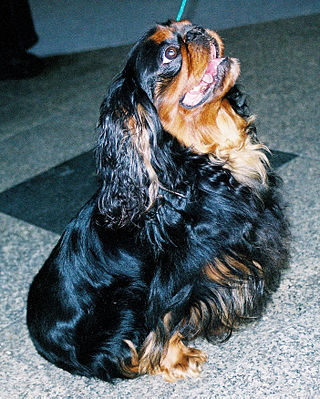
The King Charles Spaniel is a small dog breed of the spaniel type. In 1903, The Kennel Club combined four separate toy spaniel breeds under this single title. The other varieties merged into this breed were the Blenheim, Ruby and Prince Charles Spaniels, each of which contributed one of the four coat colours now seen in the breed.

The Giant Schnauzer is a breed of dog developed in the 17th century in Germany. It is the largest of the three breeds of Schnauzer—the other two breeds being the Standard Schnauzer and the Miniature Schnauzer. Originally bred to assist on farms by driving livestock to market and guarding the farmer's property, the breed eventually moved into the city, where it worked guarding breweries, butchers' shops, stockyards and factories. It was unknown outside of Bavaria until it became popular as a military dog during World War I and World War II.
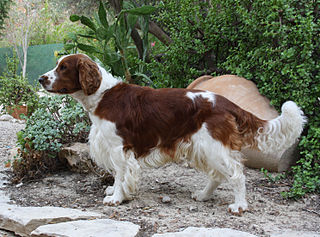
The Welsh Springer Spaniel is a breed of dog and a member of the spaniel family. Thought to be comparable to the old Land Spaniel, they are similar to the English Springer Spaniel and historically have been referred to as both the Welsh Spaniel and the Welsh Cocker Spaniel. They were relatively unknown until a succession of victories in dog trials by the breed increased its popularity. Following recognition by The Kennel Club in 1902, the breed gained the modern name of Welsh Springer Spaniel. The breed's coat only comes in a single colour combination of white with red markings, usually in a piebald pattern. Loyal and affectionate, they can become very attached to family members and are wary of strangers. Health conditions are limited to those common among many breeds of dog, although they are affected more than average by hip dysplasia and some eye conditions. They are a working dog, bred for hunting, and while not as rare as some varieties of spaniel, they are rarer than the more widely known English Springer Spaniel with which they are sometimes confused.

The Boykin Spaniel is a medium-sized breed of dog, a Spaniel bred for hunting wild turkeys and ducks in the Wateree River Swamp of South Carolina, in the United States. It is the state dog of South Carolina, where it was discovered and further developed by hunters in the early through mid 1900s. September 1 is Boykin Spaniel Day in South Carolina, originally established in 1984.

The Sussex Spaniel is a breed of dog native to Sussex in southern England. It is a low, compact spaniel and is as old a breed as and similar in appearance to the Clumber Spaniel. They can be slow-paced, but can have a clownish and energetic temperament. They suffer from health conditions common to spaniels and some large dogs, as well as a specific range of heart conditions and spinal disc herniation.

The French Spaniel is a breed of dog of the Spaniel-like setter. It was developed in France and Canada as a hunting dog, descended from dogs of the 14th century. Popular with royalty during the Middle Ages, it nearly became extinct by the turn of the 20th century but was saved by the efforts of Father Fournier, a French priest. One of the largest breeds of Spaniel, it typically has a white coat with brown markings. It is a friendly breed that has few health issues, but can be affected by a syndrome called acral mutilation and analgesia. The breed is recognised by Canadian and international kennel clubs but not by The Kennel Club (UK). The American Kennel Club has included the breed in its Foundation Stock Service, the first step to full recognition.
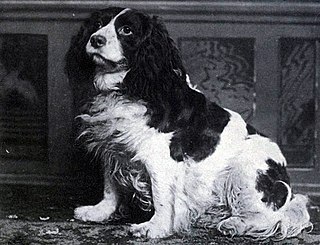
The Norfolk Spaniel or Shropshire Spaniel is an extinct breed of dog since the early 20th century. It was originally thought to have originated from the work of one of the Dukes of Norfolk, but this theory was disproven after being in doubt during the later part of the 19th century. The term was used to designate springer type spaniels that were neither Sussex nor Clumber Spaniels, and attempts were made to use it to specify a breed that would later become known as the English Springer Spaniel.
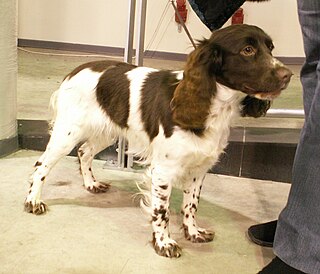
The Russian Spaniel is a type of spaniel first standardised in 1951 in the Soviet Union after World War II by cross breeding English Cocker Spaniels, English Springer Spaniels and other spaniel breeds. In 1951, the standard of the Russian spaniel was adopted, the selection of dogs for breeding began to be carried out in accordance with the requirements. Physically it is similar to a Cocker Spaniel, but has a shorter, tighter coat and a longer body. Developed and used as hunting dogs, this breed does not suffer from any major health complaints other than those normally associated with spaniels. It is the only gun dog breed originated in Russia. It is used for hunting game birds and hares. Popular in its native Russia, the breed was only introduced overseas in the 1990s, and is not yet recognised by any major kennel clubs, but is recognised by Russian Kynological Federation.

The Golden Retriever is a Scottish breed of retriever dog of medium size. It is characterised by a gentle and affectionate nature and a striking golden coat. It is a working dog, and registration is subject to successful completion of a working trial. It is commonly kept as a pet and is among the most frequently registered breeds in several Western countries; some may compete in dog shows or obedience trials, or work as a guide dog.
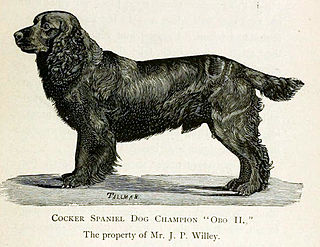
Ch. Obo (1882–1895) was an American Cocker Spaniel who is considered to be the father of the modern breed, though physically, he was different from today's American Cocker. During his day, he was a successful show dog, winner of many Best-in-Show titles.























